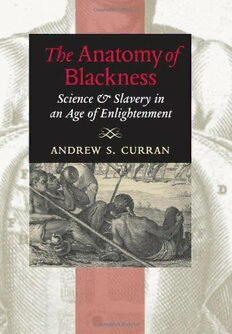
The Anatomy of Blackness: Science and Slavery in an Age of Enlightenment PDF
Preview The Anatomy of Blackness: Science and Slavery in an Age of Enlightenment
The Anatomy of Blackness This page intentionally left blank The Anatomy of Blackness Science & Slavery in an Age of Enlightenment a andrew s. curran The Johns Hopkins University Press Baltimore © 2011 The Johns Hopkins University Press All rights reserved. Published 2011 Printed in the United States of America on acid-free paper 2 4 6 8 9 7 5 3 1 The Johns Hopkins University Press 2715 North Charles Street Baltimore, Maryland 21218-4363 www.press.jhu.edu Library of Congress Cataloging-in-Publication Data Curran, Andrew S. The anatomy of blackness : science and slavery in an age of Enlightenment / Andrew S. Curran. p. cm. Includes bibliographical references and index. ISBN-13: 978-1-4214-0150-8 (hardcover : acid-free paper) ISBN-10: 1-4214-0150-9 (hardcover : acid-free paper) 1. French literature—18th century—History. 2. French literature—19th century— History. 3. Blacks—Race identity. 4. Travel writing—History and criticism. 5. Blacks in literature. 6. Africa—In literature. I. Title. PQ265.C87 2011 840.9'352996—dc22 2010050254 A catalog record for this book is available from the British Library. Special discounts are available for bulk purchases of this book. For more information, please contact Special Sales at 410-516-6936 or [email protected]. The Johns Hopkins University Press uses environmentally friendly book materials, including recycled text paper that is composed of at least 30 percent post-consumer waste, whenever possible. To the memory of my father, Thomas C. Curran a This page intentionally left blank Contents Preface ix Acknowledgments xiii Introduction: Tissue Samples in the Land of Conjecture 1 Definingle Nègre 6/The New Africanist Discourse after 174011/ The Contexts of Representation 15/Representing Africanist Discourse 18/ Anatomizing the History of Blackness 26 1 Paper Trails: Writing the African, 1450–1750 29 The Early Africanists: The Episodic and the Epic 32/Rationalizing Africa 38/ The Birth of the Caribbean African 48/Jean-Baptiste Labat 58/Labat on Africa62/Processing the African Travelogue: Prévost’s Histoire générale des voyages67/Rousseau’sAfrique70 2 Sameness and Science, 1730–1750 74 The Origin of Shared Origins 76/Toward a “Scientific” Monogenesis 79/ Historicizing the Human in an Era of Empiricism: The Role of the Albino 87/ Creating the Blafard95/Buffonian Monogenesis: The Nègre as Same 105/ Blackness Qualified: Breaking down the Nègre107/The Colonial African and the Rare Buffonian Je113 3 The Problem of Difference: Philosophes and the Processing of African “Ethnography,” 1750–1775 117 The “Symptoms” of Blackness: Africanist “Facts,” 1750–1770118/Montesquieu and the “Refutation” of Difference 130/The Nagging Context of Montesquieu’s Anti- slavery Diatribe 133/Voltaire: The Philosophe as Essentialist 137/Voltaire and the viii Contents Albino of 1744142/Voltaire, the Nègre, and Human Merchandise 145/Processing Africa and Africans in the Encyclopédie149/The Preternatural History of Black African Difference 157/Teaching Degeneration: Valmont de Bomare’s Dictionnaire d’histoire naturelle 162 4 The Natural History of Slavery,1770–1802 167 The Hardening of Climate Theory and the Birth of New Racial Categories circa1770–1785169/Toward a Human Biopolitics circa 1750–1770176/ The Politics of Slavery in the Encyclopédie181/Mercier and Saint-Lambert and the New Natural History 186/The Synchretism of the 1770s: Grappling with “Nature’s Mistreatment” of the Nègre190/Anti-slavery Rhetoric in Raynal’s Histoiredes deux Indes 194/The Era of Negrophilia 199/Epilogue: The Natural History of the Noirin an Age of Revolution 204 Coda: Black Africans and the Enlightenment Legacy 216 Notes 225 Works Cited 275 Index 295 Preface From its inception, I was convinced that this book would require an explana- tory preface. After all, it confronts the reader with the same set of eighteenth- and nineteenth-century beliefs about black Africans that the Academy has been deconstructing for the past forty years. The people who ultimately read this book will often find the unpleasantness of the past in these pages, and without the same mediation that university professors generally provide their students as a matter of course. The Anatomy of Blackness has three overlapping narratives. The first relates how eighteenth-century naturalists and philosophes drew from travel litera- ture to discuss the perceived problem of human blackness within the nascent human sciences. The second describes how a number of now-forgotten anato- mists revolutionized the era’s understanding of the black African by empha- sizing both the supposed liabilities of this group and the corresponding “ad- vantages” of whiteness. The third charts the shift of the slavery debate itself, from the moral, mercantile, and theological realms toward that of the black body itself. Not unexpectedly, such an approach reveals more about Europeans (and their secondary construction of themselves) than it does about real Africans. Readers should bear in mind that this is not a book about black African agency, or about how Africans grappled with the realities of European aggression and mercantile exploitation in Africa. Nor is it a book about how men and women of African descent undertook their own revolution at the end of the eigh- teenth century, appropriating and deploying a series of republican ideals that certainly had not been imagined with them in mind. In a word, this study focuses on the textualization of the black African. During the course of this project, several people asked me if I thought my method might inadvertently “ventriloquize or replicate” some of the era’s structures of oppression; one person suggested that I should use more sensi- tive racial or ethnic categories when writing about black Africans. Such “en-
